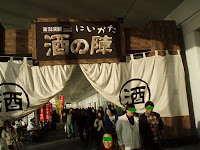
On 28 of March, when I visited Kawagoe City, I could have a study tour into the factory of the above Matsumoto Soy Sauce Store. This factory is adjacent to the "Kamonrakuza" store. Incidentally, the brewing facilities of Koedo Kagamiyama Brewery are on the same premises of this soy sauce factory.
We were ushered into an old storehouse called Tempo-gura by a guide from Matsumoto Soy Sauce Store. Inside the storehouse, I saw arranged wooden tanks used for making soy source in the dark space filled with cool air. There are about 40 tanks in this building according to the guide. He said that about six thousand to eight thousand 1.8-litter bottles of soy sauce could be made with a single tank.
These wooden tanks looked very old, so I asked the guide, "What will you do if a tank decays or break down and you cannot use it any more." He said, "Making one wooden tank will cost us about 15 million yen so we need to handle these tanks carefully so that we can use them as long as possible."
He explained, "It costs 1 to 1.5 million yen to make a bamboo hoop, which secures wooden pieces to form a tank. However, it is very difficult to attach a new hoop to a tank and to tightly fasten it. So, we usually prepare an iron hoop, which costs about 100 thousand yen. However, iron hoops can be used for only two to three years."
His explanation continued, "Soil is placed on the roof beneath the roof tiles of the storehouse building, providing heat insulation." Inside the building, I looked up and saw thick beams and pillars, which were supporting the heavy roof. These beams and pillars looked dirty, there were spider webs in places. However, they leave these beams and pillars unclean. He said that cleaning these things too much damaged the natural yeast fungus living inside the building. These yeast fungus are very important for them to make soy sauce.


He also told that different tanks had different conditions and different tanks produced soy with slightly different flavors.
Probably, this storehouse is maintaining a temperature, humidity, and other conditions which are favorable for microorganisms including soy yeast fungus. I felt this storehouse itself were alive. This building, the wooden tanks, and other tools of this factory must be invaluable assets of Japanese brewing culture and technology. I hope that Matsumoto Soy Sauce Store will maintain such assets in the future.


Today's Sake
Tokubetsu-junmai Muroka Nama Genshu Kagamiyama (Koedo Kagamiyama Brewery)
I hear there used to be Kagamiyama Brewery near the Honkawagoe Station before. Unfortunately, this brewery discontinued its operation in 2000. Then, in 2007, Kawagoe citizens and the municipal administration hoped the restoration of the brewery, and the new Koedo Kagamiyama Brewery was established on the premises of Matsumoto Soy Sauce Store. Thus, the reputed Kagamiyama sake was revived. Therefore, Koedo Kagamiyama Brewery is a young brewery, which has been operating only for two years or so. This brewery is making sakes whose classes are higher than junmaishu, and its sakes are all carefully "hand-made" by using the tray or box method for koji preparation and bag-hanging method or fune-pressing method for pressing sake.
Last year when I visited Kawagoe, I had a chance to drink this Kagamiyama and found it very attractive, and I became a fan of this wonderful sake. This tokubetsu-junmai is also good.
Seimaibuai: 60%
Alcohol: 17-18%
















